#kirkuk
Text

A US raid in Iraq has killed 5.
The US and UK are being shady as shit since the truce ended and it doesn't bode well.
#free gaza#free palestine#gaza strip#irish solidarity with palestine#palestine#gaza#news on gaza#al jazeera#boycott israel#israel#USA#Kirkuk#Iraq#Islamic Resistance
16 notes
·
View notes
Photo

By Yarb Talal Victor
Kirkuk, Iraq
#curators on tumblr#nature#travel#landscape#iraq#mountains#middle east#asia#kirkuk#yarb talal victor
347 notes
·
View notes
Photo

Accessories Handmade 🖐️ متوفر باللونين Sliver-gold متوفر التوصيل داخل العراق وكافة دول العالم/ خدمة التوصيل الدولي . . . . . جمالووو 🔥🔥🔥🔥 . . @ph_ahmed_90 .🖤🖤🖤 العراق / كركوك/ شارع المحافظة القديمة / مقابل جامع كركوك الكبير الفرع الثاني/شارع المحافظة القديمة/ قرب فندق الصنوبر ☎️ +9647707552710 . . . . #newcollection #weddingdress #iraq #australia #america #erbil #baghdad #weddinginspiration #فساتين #اعراس #dubai #austin #canda #فساتين_زواج #زفاف #فساتين_فخمه #kirkuk #المنصور #الموصل #العراق # #اعراسنا #حفلات_تخرج_زواج_اعراس_تنسيقي_حفلات_عروسه_فرح_ملكه_غمره_سابع_مواليد_زفات السعوديه #السعودية🇸🇦 #nazikmoda #nazik_moda (at Kirkuk) https://www.instagram.com/p/CmltQmBNpQW/?igshid=NGJjMDIxMWI=
#newcollection#weddingdress#iraq#australia#america#erbil#baghdad#weddinginspiration#فساتين#اعراس#dubai#austin#canda#فساتين_زواج#زفاف#فساتين_فخمه#kirkuk#المنصور#الموصل#العراق#اعراسنا#حفلات_تخرج_زواج_اعراس_تنسيقي_حفلات_عروسه_فرح_ملكه_غمره_سابع_مواليد_زفات#السعودية🇸🇦#nazikmoda#nazik_moda
4 notes
·
View notes
Text

Prime Ride into Space With Bezos and Kirk by @ltcartoons
Like this toon? See the merch! https://tinyurl.com/83wxfcns
#jeff bezos#bezos#kirk/spock#kirkuk#kirk art#captain kirk#space#star trek#star trek fan art#star trek comic#spock#mister spock#mr spock#amazon#amazon deals#amazon prime#rick london#ricklondon#humor#funny
3 notes
·
View notes
Text

Prime Ride Into Space With Jeff & Kirk by @ltcartoons
See this toon merch! https://tinyurl.com/83wxfcns
#jeff bezos#bezos#kirk/spock#kirkuk#kirk art#captain kirk#space#star trek#star trek fan art#star trek comic#spock#mister spock#mr spock#amazon#amazon deals#amazon prime#rick london#ricklondon#humor#funny
2 notes
·
View notes
Photo

رفوف خشبية الارتفاع :45 سم يتوفر بالوان مختلفة الازرق والابيض والبني سعر الزوج : 15 الف دينار تختة خانة يوفر لكم تصاميم الأنارة والديكورات الخشبية للطلب والاستفسار راسلونا عبر الدايركت او الواتساب 07731526236 تتوفر خدمة التوصيل لكافة المحافظات #sulaimany #kurdistan #erbil #hawler #kurd #duhok #instagram #dhok #nicegirl #newmodil #kurdistanfashion #jlubarg #fashionmodil #erbilmarket #kurdish #kirkuk #tablomall #parisfashion #nice #newmoda #kurdishinsta #girl #fashionkurdish #bigsizedashion #like #iraq #shose #paris_fll #newstyile #moda https://www.instagram.com/p/CetPeWMMHcr/?igshid=NGJjMDIxMWI=
#sulaimany#kurdistan#erbil#hawler#kurd#duhok#instagram#dhok#nicegirl#newmodil#kurdistanfashion#jlubarg#fashionmodil#erbilmarket#kurdish#kirkuk#tablomall#parisfashion#nice#newmoda#kurdishinsta#girl#fashionkurdish#bigsizedashion#like#iraq#shose#paris_fll#newstyile#moda
2 notes
·
View notes
Photo

بەهۆی بارانبارین خانوو بەسەر دایکێک و دوو منداڵدا لە گوندێکی کەرکووک دەڕووخێت و لە شیرینیی خەودا گیان لەدەستدەدەن؛ منداڵەکان دوو ساڵ و چوار ساڵان بوون A mother and two children die in their sleep after their house collapsed in a village in Kirkuk due to heavy rains. The children were two and four years old وفاة أم وطفلين أثناء نومهم بعد انهيار منزلهم في قرية في كركوك بسبب الأمطار الغزيرة. كان الأطفال في الثانية والرابعة من العمر #karkuk #kirkuk #iraq #water #winter (at Kirkuk, Shorja,) https://www.instagram.com/p/Cpj2HZIsb3E/?igshid=NGJjMDIxMWI=
0 notes
Photo

🏆𝐘𝐈𝐋𝐈𝐍 𝐆İ𝐘İ𝐌 𝐌𝐀𝐑𝐊𝐀𝐒𝐈 🌟Ü𝐍𝐋Ü𝐋𝐄𝐑İ𝐍 𝐌𝐀𝐑𝐊𝐀𝐒𝐈 🇮🇹𝗥𝗢𝗕𝗘𝗥𝗧𝗢 𝗠𝗜𝗟𝗔𝗡𝗢 #iraq #ıraq #iraqfashionpost #erbil #erbilcity #erbilfashion #sulaymaniyah #baghdad_mall #baghdad #mosul #ramadi #kirkuk #najaf_fashion #najaf #karbala #basrah #halabja #duhok #zakho #samawah #nasiriyah #aldiwaniyah #hillah #baghdad_mall_ #duhokfashion #kirkukfashion #ırak #ملابسرجالية (Robertomilanomerter) https://www.instagram.com/p/Cg4XQGzI82-d70VGIZT1IW-aso3fMurS6YhGfU0/?igshid=NGJjMDIxMWI=
#iraq#ıraq#iraqfashionpost#erbil#erbilcity#erbilfashion#sulaymaniyah#baghdad_mall#baghdad#mosul#ramadi#kirkuk#najaf_fashion#najaf#karbala#basrah#halabja#duhok#zakho#samawah#nasiriyah#aldiwaniyah#hillah#baghdad_mall_#duhokfashion#kirkukfashion#ırak#ملابسرجالية
0 notes
Text
While we're here and everyone is listening. Free fucking Kurdistan
14 notes
·
View notes
Text
so obsessed with basim's mother and the idea of her that exists in my head
#amber-eyed and dark with facial deq signaling#her tribal affiliation and like so deeply spiritual—beautiful too#but not overtly so or in a way that draws the eye#a nomadic herder of the plains of outermost kurdistan between like#kirkuk and baghdad her tribe did visit the cities to commerce#ideally she met her husband while he was following al-mamun as#an esteemed member of his court#i don't have a name yet all i know is that basim remembers her#almost like a dream
0 notes
Text
Iraqi forces raid Daesh (ISIS) locations, capture dozens
New Post has been published on https://www.timesofocean.com/iraqi-forces-raid-daesh-locations-capture-dozens/
Iraqi forces raid Daesh (ISIS) locations, capture dozens

Baghdad (The Times Groupe)- The Iraqi military says it has captured 38 militants from the Daesh (ISIS) terror group.
Ali Al Fariji, chief of Kirkuk’s operations command, told The Times Groupe that a large quantity of weapons and ammunition were seized during Saturday’s raid.
Eight terror groups’ shelters were also destroyed, according to the official.
Recent months have seen an increase in attacks blamed on Daesh terrorists in Iraq, especially in Salahuddin, Diyala and Kirkuk.
The Iraqi government declared victory against Daesh in 2017 by reclaiming all of the territory occupied by the terror group in 2014, about a third of the country.
The terror group still maintains sleeper cells throughout Iraq and occasionally attacks.
Iraqi forces continue to conduct frequent operations against the group.
#Ali Al Fariji#All news about Terrorism#asia news#Daesh (ISIS) terror group#iraq news#Iraqi government#Iraqi military#Kirkuk's operations command#latest News#Latest News & Photos about terrorism#middle east affairs#middle east news#More about terrorism & ISIS#Terrorism news headlines#The Times Groupe#Times Of Ocean#Unravel News#World
0 notes
Text
The most important deity you've never heard of: the 3000 years long history of Nanaya
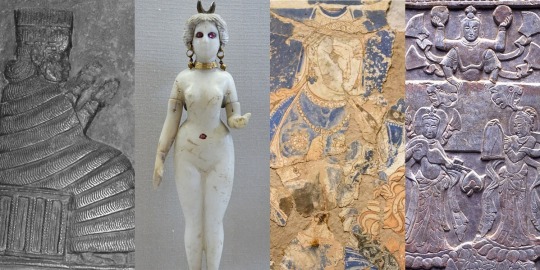
Being a major deity is not necessarily a guarantee of being remembered. Nanaya survived for longer than any other Mesopotamian deity, spread further away from her original home than any of her peers, and even briefly competed with both Buddha and Jesus for relevance. At the same time, even in scholarship she is often treated as unworthy of study. She has no popculture presence save for an atrocious, ill-informed SCP story which can’t get the most basic details right. Her claims to fame include starring in fairly explicit love poetry and appearing where nobody would expect her. Therefore, she is the ideal topic to discuss on this blog.
This is actually the longest article I published here, the culmination of over two years of research. By now, the overwhelming majority of Nanaya-related articles on wikipedia are my work, and what you can find under the cut is essentially a synthesis of what I have learned while getting there. I hope you will enjoy reading it as much as I enjoyed working on it.
Under the cut, you will learn everything there is to know about Nanaya: her origin, character, connections with other Mesopotamian deities, her role in literature, her cult centers… Since her history does not end with cuneiform, naturally the later text corpora - Aramaic, Bactrian, Sogdian and even Chinese - are discussed too. The article concludes with a short explanation why I see the study of Nanaya as crucial.
Dubious origins and scribal wordplays: from na-na to Nanaya
Long ago Samuel Noah Kramer said that “history begins in Sumer”. While the core sentiment was not wrong in many regards, in this case it might actually begin in Akkad, specifically in Gasur, close to modern Kirkuk. The oldest possible attestation of Nanaya are personal names from this city with the element na-na, dated roughly to the reign of Naram-Sin of Akkad, so to around 2250 BCE. It’s not marked in the way names of deities in personal names would usually be, but this would not be an isolated case.
The evidence is ultimately mixed. On one hand, reduplicated names like Nana are not unusual in early Akkadian sources, and -ya can plausibly be explained as a hypocoristic suffix. On the other hand, there is not much evidence for Nanaya being worshiped specifically in the far northeast of Mesopotamia in other periods. Yet another issue is that there is seemingly no root nan- in Akkadian, at least in any attested words.
The main competing proposal is that Nanaya originally arose as a hypostasis of Inanna but eventually split off through metaphorical mitosis, like a few other goddesses did, for example Annunitum. This is not entirely implausible either, but ultimately direct evidence is lacking, and when Nanaya pops up for the first time in history she is clearly a distinct goddess.
There are a few other proposals regarding Nanaya’s origin, but they are considerably weaker. Elamite has the promising term nan, “day” or “morning”, but Nanaya is entirely absent from the Old Elamite sources you’d expect to find her in if Mesopotamians imported her from the east. Therefore, very few authors adhere to this view. The hypothesis that she was an Aramaic goddess in origin does not really work chronologically, since Aramaic is not attested in the third millennium BCE at all. The less said about attempts to connect her to anything “Proto-Indo-European”, the better.
Like many other names of deities, Nanaya’s was already a subject of etymological speculation in antiquity. A late annotated version of the Weidner god list, tablet BM 62741, preserves a scribe’s speculative attempt at deriving it from the basic meaning of the sign NA, “to call”, furnished with a feminine suffix, A. Needless to say, like other such examples of scribal speculation, some of which are closer to playful word play than linguistics, it is unlikely to reflect the actual origin of the name.
Early history: Shulgi-simti, Nanaya’s earliest recorded #1 fan
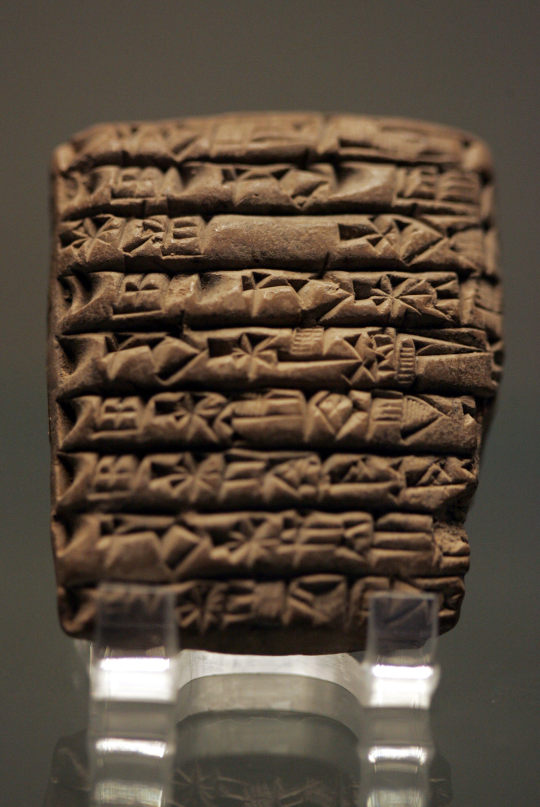
A typical Ur III administrative tablet listing offerings to various deities (wikimedia commons)
The first absolutely certain attestations of Nanaya, now firmly under her full name, have been identified in texts from the famous archive from Puzrish-Dagan, modern Drehem, dated to around 2100 BCE. Much can be written about this site, but here it will suffice to say that it was a center of the royal administration of the Third Dynasty of Ur ("Ur III") responsible for the distribution of sacrificial animals.
Nanaya appears there in a rather unique context - she was one of the deities whose cults were patronized by queen Shulgi-simti, one of the wives of Shulgi, the successor of the dynasty’s founder Ur-Namma.
We do not know much about Shulgi-simti as a person - she did not write any official inscriptions announcing her preferred foreign policy or letters to relatives or poetry or anything else that typically can be used to gain a glimpse into the personal lives of Mesopotamian royalty. We’re not really sure where she came from, though Eshnunna is often suggested as her hometown. We actually do not even know what her original name was, as it is assumed she only came to be known as Shulgi-simti after becoming a member of the royal family. Tonia Sharlach suggested that the absence of information about her personal life might indicate that she was a commoner, and that her marriage to Shulgi was not politically motivated
The one sphere of Shulgi-simti’s life which we are incredibly familiar with are her religious ventures. She evidently had an eye for minor, foreign or otherwise unusual goddesses, such as Belet-Terraban or Nanaya.
She apparently ran what Sharlach in her “biography” of her has characterized as a foundation. It was tasked with sponsoring various religious celebrations. Since Shulgi-simti seemingly had no estate to speak of, most of the relevant documents indicate she procured offerings from a variety of unexpected sources, including courtiers and other members of the royal family. The scale of her operations was tiny: while the more official religious organizations dealt with hundreds or thousands of sacrificial animals, up to fifty or even seventy thousand sheep and goats in the case of royal administration, the highest recorded number at her disposal seems to be eight oxen and fifty nine sheep.
A further peculiarity of the “foundation” is that apparently there was a huge turnover rate among the officials tasked with maintaining it. It seems nobody really lasted there for much more than four years. There are two possible explanations: either Shulgi-simti was unusually difficult to work with, or the position was not considered particularly prestigious and was, at the absolute best, viewed as a stepping stone.
While the Shulgi-simti texts are the earliest evidence for worship of Nanaya in the Ur III court, they are actually not isolated. When all the evidence from the reigns of Shulgi and his successors is summarized, it turns out that she quickly attained a prominent role, as she is among the twelve deities who received the most offerings. However, her worship was seemingly limited to Uruk (in her own sanctuary), Nippur (in the temple of Enlil, Ekur) and Ur. Granted, these were coincidentally three of the most important cities in the entire empire, so that’s a pretty solid early section of a divine resume. She chiefly appears in two types of ceremonies: these tied to the royal court, or these mostly performed by or for women. Notably, a festival involving lamentations (girrānum) was held in her honor in Uruk.
To understand Nanaya’s presence in the two aforementioned contexts, and by extension her persistence in Mesopotamian religion in later periods, we need to first look into her character.
The character of Nanaya: eroticism, kingship, and disputed astral ventures

Corona Borealis (wikimedia commons)
Nanaya’s character is reasonably well defined in primary sources, but surprisingly she was almost entirely ignored in scholarship quite recently. The first study of her which holds up to scrutiny is probably Joan Goodnick Westenholz’s article Nanaya, Lady of Mystery from 1997. The core issue is the alleged interchangeability of goddesses. From the early days of Assyriology basically up to the 1980s, Nanaya was held to be basically fully interchangeable with Inanna. This obviously put her in a tough spot. Still, over the course of the past three decades the overwhelming majority of studies came to recognize Nanaya as a distinct goddess worthy of study in her own right. You will still stumble upon the occasional “Nanaya is basically Inanna”, but now this is a minority position. Tragically it’s not extinct yet, most recently I’ve seen it in a monograph published earlier this year.
With these methodological and ideological issues out of the way, let’s actually look into Nanaya’s character, as promised by the title of this section. Her original role was that of a goddess of love. It is already attested for her at the dawn of her history, in the Ur III period. Her primary quality was described with a term rendered as ḫili in Sumerian and kuzbu in Akkadian. It can be variously translated as “charm”, “luxuriance”, “voluptuousness”, “sensuality” or “sexual attractiveness”. This characteristic was highlighted by her epithet bēlet kuzbi (“lady of kuzbu”) and by the name of her cella in the Eanna, Eḫilianna. The connection was so strong that this term appears basically in every single royal inscription praising her. She was also called bēlet râmi, “lady of love”. Nanaya’s role as a love goddess is often paired with describing her as a “joyful” or “charming” deity.
It needs to be stressed that Nanaya was by no metric the goddess of some abstract, cosmic love or anything like that. Love incantations and prayers related to love are quite common, and give us a solid glimpse into this matter. Nanaya’s range of activity in them is defined pretty directly: she deals with relationships (and by extension also with matters like one-sided crushes or arguments between spouses), romance and with strictly sexual matters. For an example of a hymn highlighting her qualifications when it comes to the last category, see here. The text is explicit, obviously.
We can go deeper, though. There is also an incantation whose incipit at first glance leaves little to imagination:

However, the translator, Giole Zisa, notes there is some debate over whether it’s actually about having sex with Nanaya or merely about invoking her (and other deities) while having sex with someone else. A distinct third possibility is that she’s not even properly invoked but that “oh, Nanaya” is simply an exclamation of excitement meant to fit the atmosphere, like a specialized version of the mainstay of modern erotica dialogue, “oh god”.
While this romantic and sexual aspect of Nanaya’s character is obviously impossible to overlook, this is not all there was to her. She was also associated with kingship, as already documented in the Ur III period. She was invoked during coronations and mourning of deceased kings. In the Old Babylonian period she was linked to investiture by rulers of newly independent Uruk.
A topic which has stirred some controversy in scholarship is Nanaya’s supposed astral role. Modern authors who try to present Nanaya as a Venus deity fall back on rather faulty reasoning, namely asserting that if Nanaya was associated with Inanna and Inanna personified Venus, clearly Nanaya did too. Of course, being associated with Inanna does not guarantee the same traits. Shaushka was associated with her so closely her name was written with the logogram representing her counterpart quite often, and lacked astral aspects altogether.
No primary sources which discuss Nanaya as a distinct, actively worshiped deity actually link her with Venus. If you stretch it you will find some tidbits like an entry in a dictionary prepared by the 10th century bishop Hasan bar Bahlul, who inexplicably asserted Nanaya was the Arabic name of the planet Venus. As you will see soon, there isn’t even a possibility that this reflected a relic of interpretatio graeca. The early Mandaean sources, many of which were written when at least remnants of ancient Mesopotamian religion were still extant, also do not link Nanaya with Venus. Despite at best ambivalent attitude towards Mesopotamian deities, they show remarkable attention to detail when it comes to listing their cult centers, and on top of that Mesopotamian astronomy had a considerable impact on Mandaeism, so there is no reason not to prioritize them, as far as I am concerned.
As far as the ancient Mesopotamian sources themselves go, the only astral object with a direct connection to Nanaya was Corona Borealis (BAL.TÉŠ.A, “Dignity”), as attested in the astronomical compendium MUL.APIN. Note that this is a work which assigns astral counterparts to virtually any deity possible, though, and there is no indication this was a major part of Nanaya’s character. Save for this single instance, she is entirely absent from astronomical texts.
A further astral possibility is that Nanaya was associated with the moon. The earliest evidence is highly ambiguous: in the Ur III period festivals held in her honor might have been tied to phases of the moon, while in the Old Babylonian period a sanctuary dedicated to her located in Larsa was known under the ceremonial name Eitida, “house of the month”. A poem in which looking at her is compared to looking at the moon is also known. That’s not all, though. Starting with the Old Babylonian period, she could also be compared with the sun. Possibly such comparisons were meant to present her as an astral deity, without necessarily identifying her with a specific astral body. Michael P. Streck and Nathan Wasserman suggest that it might be optimal to simply refer to her as a “luminous” deity in this context. However, as you will see later it nonetheless does seem she eventually came to be firmly associated both with the sun and the moon.
Last but not least, Nanaya occasionally displayed warlike traits. It’s hardly major in her case, and if you tried hard enough you could turn any deity into a war deity depending on your political goals, though. I’d also place the incantation which casts her as one of the deities responsible for keeping the demon Lamashtu at bay here.
Nanaya in art
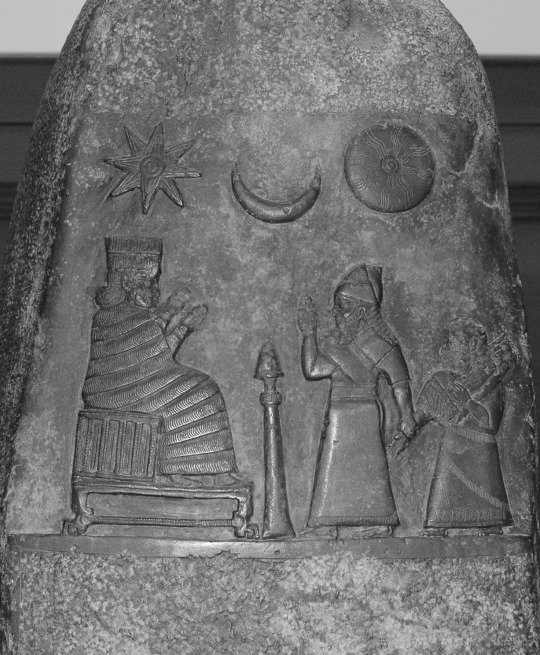
The oldest known depiction of Nanaya (wikimedia commons)
While Nanaya’s roles are pretty well defined, there surprisingly isn’t much to say about her iconography in Mesopotamian art.The oldest certain surviving depiction of her is rather indistinct: she’s wearing a tall headdress and a flounced robe. It dates to the late Kassite period (so roughly to 1200 BCE), and shows her alongside king Meli-Shipak (or maybe Meli-Shihu, reading remains uncertain) and his daughter Hunnubat-Nanaya. Nanaya is apparently invoked to guarantee that the prebend granted to the princess will be under divine protection. This is not really some unique prerogative of hers, perhaps she was just the most appropriate choice because Hunnubat-Nanaya’s name obviously reflects devotion to her.
The relief discussed above is actually the only depiction of Nanaya identified with certainty from before the Hellenistic period, surprisingly. We know that statues representing her existed, and it is hard to imagine that a popular, commonly worshiped deity was not depicted on objects like terracotta decorations and cylinder seals, but even if some of these were discovered, there’s no way to identify them with certainty. This is not unusual though, and ultimately there aren’t many Mesopotamian deities who can be identified in art without any ambiguity.
Nanaya in literature
As I highlighted in the section dealing with Nanaya’s character, she is reasonably well attested in love poetry. However, this is not the only genre in which she played a role.
A true testament to Nanaya’s prominence is a bilingual (Sumero-Akkadian) hymn composed in her honor in the first millennium BCE. It is written in the first person, and presents various other goddesses as her alternate identities. It is hardly unique, and similar compositions dedicated to Ishtar (Inanna), Gula, Ninurta and Marduk are also known.
Each strophe describes a different deity and location, but ends with Nanaya reasserting her actual identity with the words “still I am Nanaya”. Among the claimed identities included are both major goddesses in their own right (Inanna plus closely associated Annunitum and Ishara, Gula, Bau, Ninlil), goddesses relevant due to their spousal roles first and foremost (Damkina, Shala, Mammitum etc) and some truly unexpected, picks, the notoriously elusive personified rainbow Manzat being the prime example. Most of them had very little in common with Nanaya, so this might be less an attempt at syncretism, and more an elevation of her position through comparisons to those of other goddesses.
An additional possible literary curiosity is a poorly preserved myth which Wilfred G. Lambert referred to as “The murder of Anshar”. He argues that Nanaya is one of the two deities responsible for the eponymous act. I don't quite follow the logic, though: the goddess is actually named Ninamakalamma (“Lady mother of the land”), and her sole connection with Nanaya is that they occur in sequence in the unique god list from Sultantepe. Lambert saw this as a possible indication they are identical. There are no other attestations of this name, but ama kalamma does occur as an epithet of various goddesses, most notably Ninshubur. Given her juxtaposition with Nanaya in the Weidner god list - more on that later - wouldn’t it make more sense to assume it’s her? Due to obscurity of the text as far as I am aware nobody has questioned Lambert’s tentative proposal yet, though.
There isn’t much to say about the plot: Anshar, literally “whole heaven”, the father of Anu, presumably gets overthrown and might be subsequently killed. Something that needs to be stressed here to avoid misinterpretation: primordial deities such as Anshar were borderline irrelevant, and weren't really worshiped. They exist to fade away in myths and to be speculated about in elaborate lexical texts. There was no deposed cult of Anshar. Same goes for all the Tiamats and Enmesharras and so on.
Inanna and beyond: Nanaya and friends in Mesopotamian sources
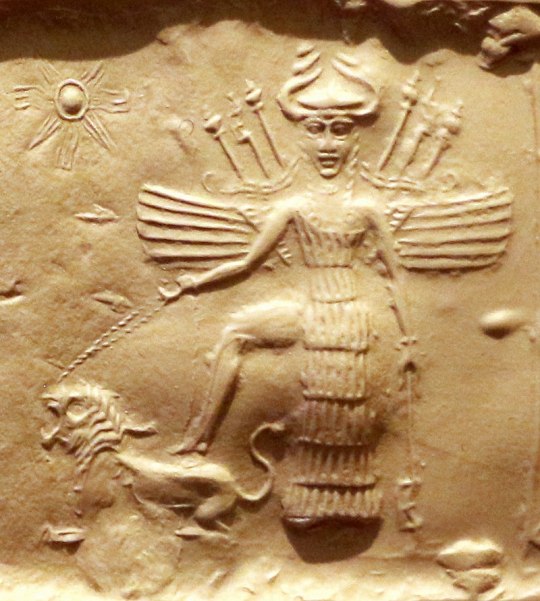
Inanna on a cylinder seal from the second half of the third millennium BCE (wikimedia commons)
Of course, Nanaya’s single most important connection was that to Inanna, no matter if we are to accept the view that she was effectively a hypostasis gone rogue or not. The relationship between them could be represented in many different ways. Quite commonly she was understood as a courtier or protegee of Inanna. A hymn from the reign of Ishbi-Erra calls her the “ornament of Eanna” (Inanna’s main temple in Uruk) and states she was appointed by Inanna to her position. References to Inanna as Nanaya’s mother are also known, though they are rare, and might be metaphorical. To my best knowledge nothing changed since Olga Drewnowska-Rymarz’s monograph, in which she notes she only found three examples of texts preserving this tradition. I would personally abstain from trying to read too deep into it, given this scarcity.
Other traditions regarding Nanaya’s parentage are better attested. In multiple cases, she “borrows” Inanna’s conventional genealogy, and as a result is addressed as a daughter of Sin (Nanna), the moon god. However, she was never addressed as Inanna’s sister: it seems that in cases where Sin and Nanaya are connected, she effectively “usurps” Inanna’s own status as his daughter (and as the sister of Shamash, while at it). Alternatively, she could be viewed as a daughter of Anu.
Finally, there is a peculiar tradition which was the default in laments: in this case, Nanaya was described as a daughter of Urash. The name in this context does not refer to the wife of Anu, though. The deity meant is instead a small time farmer god from Dilbat. To my best knowledge no sources place Nanaya in the proximity of other members of Urash’s family, though some do specify she was his firstborn daughter. To my best knowledge Urash had at least two other children, Lagamal (“no mercy”, an underworld deity whose gender is a matter of debate) and Ipte-bitam (“he opened the house”, as you can probably guess a divine doorkeeper). Nanaya’s mother by extension would presumably be Urash’s wife Ninegal, the tutelary goddess of royal palaces. There is actually a ritual text listing these three together.
In the Weidner god list Nanaya appears after Ninshubur. Sadly, I found no evidence for a direct association between these two. For what it’s worth, they did share a highly specific role, that of a deity responsible for ordering around lamma. This term referred to a class of minor deities who can be understood as analogous to “guardian angels” in contemporary Christianity, except places and even deities had their own lamma too, not just people. Lamma can also be understood at once as a class of distinct minor deities, as the given name of individual members of it, and as a title of major deities. In an inscription of Gudea the main members of the official pantheon are addressed as “lamma of all nations”, by far one of my favorite collective terms of deities in Mesopotamian literature.
A second important aspect of the Weidner god list is placing Nanaya right in front of Bizilla. The two also appear side by side in some offering lists and in the astronomical compendium MUL.APIN, where they are curiously listed as members of the court of Enlil. It seems that like Nanaya, she was a goddess of love, which is presumably reflected by her name. It has been variously translated as “pleasing”, “loving” or as a derivative of the verb “to strip”. An argument can be made that Bizilla was to Nanaya what Nanaya was to Inanna. However, she also had a few roles of her own. Most notably, she was regarded as the sukkal of Ninlil. She may or may not also have had some sort of connection to Nungal, the goddess of prisons, though it remains a matter of debate if it’s really her or yet another, accidentally similarly named, goddess.

An indistinct Hurro-Hittite depiction of Ishara from the Yazilikaya sanctuary (wikimedia commons)
In love incantations, Nanaya belonged to an informal group which also included Inanna, Ishara, Kanisurra and Gazbaba. I do not think Inanna’s presence needs to be explained. Ishara had an independent connection with Inanna and was a multi-purpose deity to put it very lightly; in the realm of love she was particularly strongly connected with weddings and wedding nights. Kanisurra and Gazbaba warrant a bit more discussion, because they are arguably Nanaya’s supporting cast first and foremost.
Gazbaba is, at the core, seemingly simply the personification of kuzbu. Her name had pretty inconsistent orthography, and variants such as Kazba or Gazbaya can be found in primary sources too. The last of them pretty clearly reflects an attempt at making her name resemble Nanaya’s. Not much can be said about her individual character beyond the fact she was doubtlessly related to love and/or sex. She is described as the “grinning one” in an incantation which might be a sexual allusion too, seeing as such expressions are a mainstay of Akkadian erotic poetry.
Kanisurra would probably win the award for the fakest sounding Mesopotamian goddess, if such a competition existed. Her name most likely originated as a designation of the gate of the underworld, ganzer. Her default epithet was “lady of the witches” (bēlet kaššāpāti). And on top of that, like Nanaya and Gazbaba she was associated with sex. She certainly sounds more like a contemporary edgy oc of the Enoby Dimentia Raven Way variety than a bronze age goddess - and yet, she is completely genuine.
It is commonly argued Kanisurra and Gazbaba were regarded as Nanaya’s daughters, but there is actually no direct evidence for this. In the only text where their relation to Nanaya is clearly defined they are described as her hairdressers, rather than children.
While in some cases the love goddesses appear in love incantations in company of each other almost as if they were some sort of disastrous polycule, occasionally Nanaya is accompanied in them by an anonymous spouse. Together they occur in parallel with Inanna and Dumuzi and Ishara and Almanu, apparently a (accidental?) deification of a term referring to someone without family obligations.
There is only one Old Babylonian source which actually assigns a specific identity to Nanaya’s spouse, a hymn dedicated to king Abi-eshuh of Babylon. An otherwise largely unknown god Muati (I patched up his wiki article just for the sake of this blog post) plays this role here.
The text presents a curious case of reversal of gender roles: Muati is asked to intercede with Nanaya on behalf of petitioners. Usually this was the role of the wife - the best known case is Aya, the wife of Shamash, who is implored to do just that by Ninsun in the standard edition of the Epic of Gilgamesh. It’s also attested for goddesses such as Laz, Shala, Ninegal or Ninmug… and in the case of Inanna, for Ninshubur.

A Neo-Assyrian statue of Nabu on display in the Iraq Museum (wikimedia commons)
Marten Stol seems to treat Muati and Nabu as virtually the same deity, and on this basis states that Nanaya was already associated with the latter in the Old Babylonian period, but this seems to be a minority position. Other authors pretty consistently assume that Muati was a distinct deity at some point “absorbed” by Nabu.
The oldest example of pairing Nanaya with Nabu I am aware of is an inscription dated to the reign of Marduk-apla-iddina I, so roughly to the first half of the twelfth century BCE. The rise of this tradition in the first millennium BCE was less theological and more political. With Babylon once again emerging as a preeminent power, local theologies were supposed to be subordinated to the one followed in the dominant city. Which, at the time, was focused on Nabu, Marduk and Zarpanit. Worth noting that Nabu also had a spouse before, Tashmetum (“reconciliation”). In the long run she was more or less ousted by Nanaya from some locations, though she retained popularity in the north, in Assyria. She is not exactly the most thrilling deity to discuss. I will confess I do not find the developments tied to Nanaya and Nabu to be particularly interesting to cover, but in the long run they might have resulted in Nanaya acquiring probably the single most interesting “supporting cast member” she did not share with Inanna, so we’ll come back to this later.
Save for Bizilla, Nanaya generally was not provided with “equivalents” in god lists. I am only aware of one exception, and it’s a very recent discovery. Last year the first ever Akkadian-Amorite bilingual lists were published. This is obviously a breakthrough discovery, as before Amorite was largely known just from personal names despite being a vernacular language over much of the region in the bronze age, but only one line is ultimately of note here. In a section of one of the lists dealing with deities, Nanaya’s Amorite counterpart is said to be Pidray. This goddess is otherwise almost exclusively known from Ugarit. This of course fits very well with the new evidence: recent research generally stresses that Ugarit was quintessentially an Amorite city (the ruling house even claimed descent from mythical Ditanu, who is best known from the grandiose fictional genealogies of Shamshi-Adad I and the First Dynasty of Babylon).
Sadly, we do not know how the inhabitants of Ugarit viewed Nanaya. A trilingual version of the Weidner list, with the original version furnished with columns listing Ugaritic and Hurrian counterparts of each deity, was in circulation, but the available copies are too heavily damaged to restore it fully. And to make things worse, much of it seems to boil down to scribal wordplay and there is no guarantee all of the correspondences are motivated theologically. For instance, the minor Mesopotamian goddess Imzuanna is presented as the counterpart of Ugaritic weather god Baal because her name contains a sign used as a shortened logographic writing of the latter. An even funnier case is the awkward attempt at making it clear the Ugaritic sun deity Shapash, who was female, is not a lesbian… by making Aya male. Just astonishing, really.
The worship of Nanaya
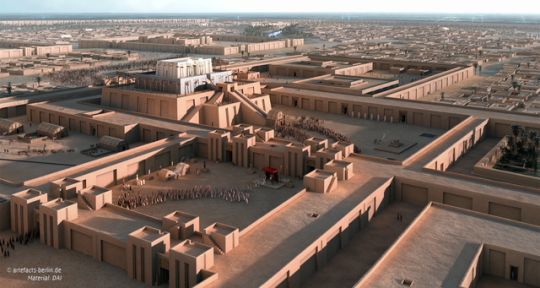
A speculative reconstruction of Ur III Uruk with the Eanna temple visible in the center (Artefacts — Scientific Illustration & Archaeological Reconstruction; reproduced here for educational purposes only, as permitted)
Rather fittingly, as a deity associated with Inanna, Nanaya was worshiped chiefly in Uruk. She is also reasonably well attested in the inscriptions of the short-lived local dynasty which regained independence near the end of the period of domination of Larsa over Lower Mesopotamia. A priest named after her, a certain Iddin-Nanaya, for a time served as the administrator of her temple, the Enmeurur, “house which gathers all the me,” me being a difficult to translate term, something like “divine powers”. The acquisition of new me is a common topic in Mesopotamian literature, and in compositions focused on Inanna in particular, so it should not be surprising to anyone that her peculiar double seemingly had similar interests.
In addition to Uruk, as well as Nippur and Ur, after the Ur III period Nanaya spread to multiple other cities, including Isin, Mari, Babylon and Kish. However, she is probably by far the best attested in Larsa, where she rose to the rank of one of the main deities, next to Utu, Inanna, Ishkur and Nergal. She had her own temple, the Eshahulla, “house of a happy heart”. In local tradition Inanna got to keep her role as an “universal” major goddess and her military prerogatives, but Nanaya overtook the role of a goddess of love almost fully. Inanna’s astral aspect was also locally downplayed, since Venus was instead represented in the local pantheon by closely associated, but firmly distinct, Ninsianna. This deity warrants some more discussion in the future just due to having a solid claim to being one of the first genderfluid literary figures in history, but due to space constraints this cannot be covered in detail here.
A later inscription from the same city differentiates between Nanaya and Inanna by giving them different epithets: Nanaya is the “queen of Uruk and Eanna” (effectively usurping Nanaya’s role) while Inanna is the “queen of Nippur” (that’s actually a well documented hypostasis of her, not to be confused with the unrelated “lady of Nippur”).
Uruk was temporarily abandoned in the late Old Babylonian period, but that did not end Nanaya’s career. Like Inanna, she came to be temporarily relocated to Kish. It has been suggested that a reference to her residence in “Kiššina” in a Hurro-Hittite literary text, the Tale of Appu, reflects her temporary stay there.
The next centuries of Nanaya are difficult to reconstruct due to scarce evidence, but it is clear she continued to be worshiped in Uruk. By the Neo-Babylonian period she was recognized as a member of an informal pentad of the main deities of the city, next to Inanna, Urkayitu, Usur-amassu and Beltu-sa-Resh. Two of them warrant no further discussion: Urkayitu was most likely a personification of the city, and Beltu-sa-Resh despite her position is still a mystery to researchers.
Usur-amassu, on the contrary, is herself a fascinating topic. First attestations of this deity, who was seemingly associated with law and justice (a pretty standard concern), come back to the Old Babylonian period. At this point, Usur-amassu was clearly male, which is reflected by the name. He appears in the god list An = Anum as a son of the weather deity couple par excellence, Adad (Ishkur) and Shala. However, by the early first millennium BCE Usur-amassu instead came to be regarded as female - without losing the connection to her parents. She did however gain a connection to Inanna, Nanaya and Kanisurra, which she lacked earlier. How come remains unknown. Most curiously her name was not modified to reflect her new gender, though she could be provided with a determinative indicating it. This recalls the case of Lagamal in the kingdom of Mari some 800 years earlier.
The end of the beginning: Nanaya under Achaemenids and Seleucids
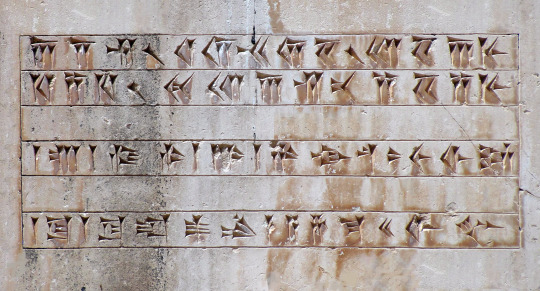
Trilingual (Persian, Elamite and Akkadian) inscription of the first Achamenid ruler of Mesopotamia, Cyrus (wikimedia commons)
After the fall of the Neo-Babylonian Empire Mesopotamia ended up under Achaemenid control, which in turn was replaced by the Seleucids. Nanaya flourished through both of these periods. In particular, she attained considerable popularity among Arameans. While they almost definitely first encountered her in Uruk, she quickly came to be venerated by them in many distant locations, like Palmyra, Hatra and Dura Europos in Syria. She even appears in a single Achaemenid Aramaic papyrus discovered in Elephantine in Egypt. It indicates that she was worshiped there by a community which originated in Rash, an area east to the Tigris. As a curiosity it’s worth mentioning the same source is one of the only attestations of Pidray from outside Ugarit. I do not think this has anything to do with the recently discovered connection between her and Nanaya… but you may never know.
Under the Seleucids, Nanaya went through a particularly puzzling process of partial syncretism. Through interpretatio graeca she was identified with… Artemis. How did this work? The key to understanding this is the fact Seleucids actually had a somewhat limited interest in local deities. All that was necessary was to find relatively major members of the local pantheon who could roughly correspond to the tutelary deities of their dynasty: Zeus, Apollo and Artemis. Zeus found an obvious counterpart in Marduk (even though Marduk was hardly a weather god). Since Nabu was Marduk’s son, he got to be Apollo. And since Nanaya was the most major goddess connected to Nabu, she got to be Artemis. It really doesn’t go deeper than that.
For what it’s worth, despite the clear difference in character this newfound association did impact Nanaya in at least one way: she started to be depicted with attributes borrowed from Artemis, namely a bow and a crescent. Or perhaps these attributes were already associated with her, but came to the forefront because of the new role. The Artemis-like image of Nanaya as an archer is attested on coins, especially in Susa, yet another city where she attained considerable popularity.
Leaving Mesopotamia: Nanaya and the death of cuneiform
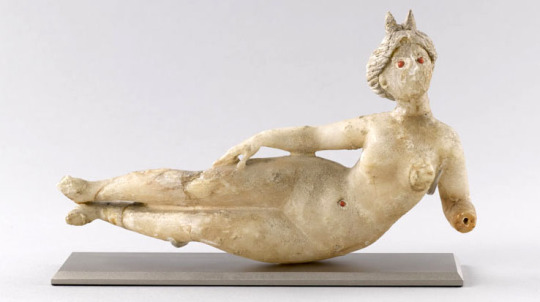
A Parthian statue of Nanaya with a crescent diadem (Louvre; reproduced here for educational purposes only. Identification follows Andrea Sinclair's proposal)
The Seleucid dynasty was eventually replaced by the Parthians. This period is often considered a symbolic end of ancient Mesopotamian religion in the strict sense. Traditional religious institutions were already slowly collapsing in Achaemenid and Seleucid times as the new dynasties had limited interest in royal patronage. Additionally, cuneiform fell out of use, and by the end of the first half of the first millennium CE the art of reading and writing it was entirely lost. This process did not happen equally quickly everywhere, obviously, and some deities fared better than others in the transitional period before the rise of Christianity and Islam as the dominant religions across the region. Nanaya was definitely one of them, at least for a time.
In Parthian art Nanaya might have developed a distinct iconography: it has been argued she was portrayed as a nude figure wearing only some jewelry (including what appears to be a navel piercing and a diadem with a crescent. The best known example is probably this standing figure, one of my all time favorite works of Mesopotamian art:

Parthian Nanaya (wikimedia commons; identification courtesy of the Louvre website and J. G. Westenholz)
For years Wikipedia had this statue mislabeled as “Astarte” which makes little sense considering it comes from a necropolis near Babylon. There was also a viral horny tweet which labeled it as “Asherah” a few months ago (I won’t link it but I will point out in addition to getting the name wrong op also severely underestimated the size). This is obviously even worse nonsense both on spatial and temporal grounds. Even if the biblical Asherah was ever an actual deity like Ugaritic Athirat and Mesopotamian Ashratum, it is highly dubious she would still be worshiped by the time this statue was made. It’s not even certain she ever was a deity, though. Cognate of a theonym is not automatically a theonym itself, and the Ugaritic texts and the Bible, even if they share some topoi, are separated by centuries and a considerable distance. This is not an Asherah post though, so if this is a topic which interests you I recommend downloading Steve A. Wiggins’ excellent monograph A Reassessment of Asherah: With Further Considerations of the Goddess.
The last evidence for the worship of Nanaya in Mesopotamia is a Mandaean spell from Nippur, dated to the fifth or sixth century CE. However, at this point Nanaya must have been a very faint memory around these parts, since the figure designated by this name is evidently male in this formula. That was not the end of her career, though. The system of beliefs she originated and thrived in was on its way out, but there were new frontiers to explore.
A small disgression is in order here: be INCREDIBLY wary of claims about the survival of Mesopotamian tradition in Mesopotamia itself past the early middle ages. Most if not all of these come from the writing of Simo Parpola, who is a 19th century style hyperdiffusionist driven by personal religious beliefs based on gnostic christianity, which he believes was based on Neo-Assyrian state religion, which he misinterprets as monotheism, or rather proto-christianity specifically (I wish I was making this up). I personally do not think a person like that should be tolerated in serious academia, but for some incomprehensible reason that isn’t the case.
New frontiers: Nanaya in Bactria
The key to Nanaya’s extraordinarily long survival wasn’t the dedication to her in Mesopotamia, surprisingly. It was instead her introduction to Bactria, a historical area in Central Asia roughly corresponding to parts of modern Afghanistan, Tajikistan and Uzbekistan. The early history of this area is still poorly known, though it is known that it was one of the “cradles of civilization” not unlike Mesopotamia, the Indus Valley or Mesoamerica. The so-called “Oxus civilization” or “Bactria-Margiana Archaeological Complex” flourished around 2500-1950 BCE (so roughly contemporarily with the Akkadian and Ur III empires in Mesopotamia). It left behind no written records, but their art and architecture are highly distinctive and reflect great social complexity.
I sadly can’t spent much time discussing them here though, as they are completely irrelevant to the history of Nanaya (there is a theory that she was already introduced to the east when BMAC was extant but it is incredibly implausible), so I will limit myself to showing you my favorite related work of art, the “Bactrian princess”:

Photo courtesy of Louvre Abu Dhabi, reproduced here for educational purposes only.
By late antiquity, which is the period we are concerned with here, BMAC was long gone, and most of the inhabitants of Bactria spoke Bactrian, an extinct Iranian language. How exactly they were related to their BMAC forerunners is uncertain. Their religious beliefs can be compared to Zoroastrianism, or rather with its less formalized forerunners followed by most speakers of Iranian languages before the rise of Zoroaster. However, there were many local peculiarities. For example, the main deity was the personified river Oxus, not Ahura Mazda. Whether this was a relic of BMAC religion is impossible to tell.We do not know exactly when the eastward transfer of Nanaya to Bactria happened. The first clear evidence for her presence in central Asia comes from the late first century BCE, from the coins of local rulers, Sapadbizes and Agesiles. It is possible that her depictions on coinage of Mesopotamian and Persian rulers facilitated her spread. Of course, it’s also important to remember that the Aramaic script and language spread far to the east in the Achaemenid period already, and that many of the now extinct Central Asian scripts were derived from it (Bactrian was written with the Greek script, though). Doubtlessly many now lost Aramaic texts were transferred to the east.
There’s an emerging view that for unclear reasons, under the Achaemenids Mesopotamian culture as a whole had unparalleled impact on Bactria. The key piece of evidence are Bactrian temples, which often resemble Mesopotamian ones. Therefore, perhaps we should be wondering not why Nanaya spread from Mesopotamia to Central Asia, but rather why there were no other deities who did, for the most part. That is sadly a question I cannot answer. Something about Nanaya simply made her uniquely appealing to many groups at once.
While much about the early history of Nanaya in Central Asia is a mystery, it is evident that with time she ceased to be viewed as a foreign deity. For the inhabitants of Bactria she wasn’t any less “authentically Iranian” than the personified Oxus or their versions of the conventional yazatas like Sraosha. Frequently arguments are made that Nanaya’s widespread adoption and popularity could only be the result of identification between her and another deity.Anahita in particular is commonly held to be a candidate. However, as stressed by recent studies there’s actually no evidence for this.
What is true is that Anahita is notably missing from the eastern Iranian sources, despite being prominent in the west from the reign of the Achaemenid emperor Artaxerxes II onward. However, it is clear that not all yazatas were equally popular in each area - pantheons will inevitably be localized in each culture. Furthermore, Anahita’s character has very little in common with Nanaya save for gender. Whether we are discussing her early not quite Zoroastrian form the Achaemenid public was familiar with or the contemporary yazata still relevant in modern Zoroastrianism, the connection to water is the most important feature of her. Nanaya didn’t have such a role in any culture.
Recently some authors suggested a much more obvious explanation for Anahita’s absence from the eastern Iranian pantheon(s). As I said, eastern Iranian communities venerated the river Oxus as a deity (or as a yazata, if you will). He was the water god par excellence, and in Bactria also the king of the gods. It is therefore quite possible that Anahita, despite royal backing from the west, simply couldn’t compete with him. Their roles overlapped more than the roles of Anahita and Nanaya. I am repeating myself but the notion of interchangeability of goddesses really needs to be distrusted almost automatically, no matter how entrenched it wouldn’t be. While we’re at it, the notion of alleged interchangeability between Anahita and Ishtar is also highly dubious, but that’s a topic for another time.

Nana (Nanaya) on a coin of Kanishka (wikimedia commons)
Nanaya experienced a period of almost unparalleled prosperity with the rise of the Kushan dynasty in Bactria. The Kushans were one of the groups which following Chinese sources are referred to as Yuezhi. They probably did not speak any Iranian language originally, and their origin is a matter of debate. However, they came to rule over a kingdom which consisted largely of areas inhabited by speakers of various Iranian languages, chiefly Bactrian. Their pantheon, documented in royal inscriptions and on coinage, was an eerie combination of mainstays of Iranian beliefs like Sraosha and Mithra and some unique figures, like Oesho, who was seemingly the reflection of Hindu Shiva. Obviously, Nanaya was there too, typically under the shortened name Nana.
The most famous Kushan ruler, emperor Kanishka, in his inscription from Rabatak states that kingship was bestowed upon him by “Nana and all the gods”. However, we do not know if the rank assigned to her indicates she was the head of the dynastic pantheon, the local pantheon in the surrounding area, or if she was just the favorite deity of Kanishka. Same goes for the rank of numerous other deities mentioned in the rest of the inscription. Her apparent popularity during Kanishka’s reign and beyond indicates her role should not be downplayed, though.
The coins of Kanishka and other Bactrian art indicate that a new image of Nanaya developed in Central Asia. The Artemis-like portrayals typical for Hellenistic times continue to appear, but she also started to be depicted on the back of a lion. There is only one possible example of such an image from the west, a fragmentary relief from Susa, and it’s roughly contemporary with the depictions from Bactria. While it is not impossible Nanaya originally adopted the lion association from one of her Mesopotamian peers, it is not certain how exactly this specific type of depictions originally developed, and there is a case to be made that it owed more to the Hellenistic diffusion of iconography of deities such as Cybele and Dionysus, who were often depicted riding on the back of large felines.
The lunar symbols are well attested in the Kushan art of Nanaya too. Most commonly, she’s depicted wearing a diadem with a crescent. However, in a single case the symbol is placed behind her back. This is an iconographic type which was mostly associated with Selene at first, but in the east it was adopted for Mah, the Iranian personification of the moon. I’d hazard a guess that’s where Nanaya borrowed it from - more on that later.
The worship of Nanaya survived the fall of the Kushan dynasty, and might have continued in Bactria as late as in the eighth century. However, the evidence is relatively scarce, especially compared with yet another area where she was introduced in the meanwhile.
Nanaya in Sogdia: new home and new friends
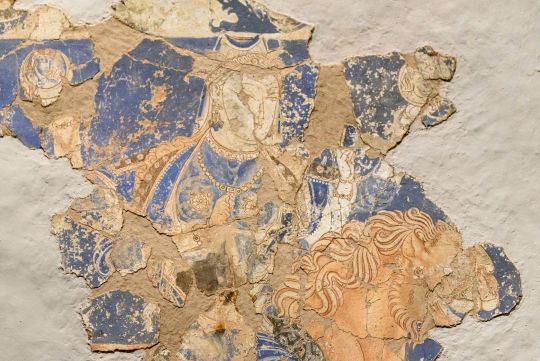
A Sogdian depiction of Nanaya from Bunjikat (wikimedia commons)
Presumably from Bactria, Nanaya was eventually introduced to Sogdia, its northern neighbor. I think it’s safe to say this area effectively became her new home for the rest of her history.
Like Bactrians, the Sogdians also spoke an eastern Iranian language, Sogdian. It has a direct modern descendant, Yaghnobi, spoken by a small minority in Tajikistan. The religions Sogdians adhered to is often described as a form of Zoroastrianism, especially in older sources, but it would appear that Ahura Mazda was not exactly the most popular deity. Their pantheon was seemingly actually headed by Nanaya. Or, at the very least, the version of it typical for Samarkand and Panijkant, since there’s a solid case to be made for local variety in the individual city-states which made up Sogdia. It seems that much like Mesopotamians and Greeks centuries before them, Sogdians associated specific deities with specific cities, and not every settlement necessarily venerated each deity equally (or at all). Nanaya's remarkable popularity is reflected by the fact the name Nanaivandak, "servant of Nanaya", is one of the most common Sogdian names in general.
It is agreed that among the Sogdians Panjikant was regarded as Nanaya’s cult center. She was referred to as “lady” of this city. At one point, her temple located there was responsible for minting the local currency. By the eighth century, coins minted there were adorned with dedications to her - something unparalleled in Sogdian culture, as the rest of coinage was firmly secular. This might have been an attempt at reasserting Sogdian religious identity in the wake of the arrival of Islam in Central Asia.
Sogdians adopted the Kushan iconography of Nanaya, though only the lion-mounted version. The connection between her and this animal was incredibly strong in Sogdian art, with no other deity being portrayed on a similar mount. There were also innovations - Nanaya came to be frequently portrayed with four arms. This reflects the spread of Buddhism through central Asia, which brought new artistic conventions from India. While the crescent symbol can still be found on her headwear, she was also portrayed holding representations of the moon and the sun in two of her hands.
Sometimes the solar disc and lunar orb are decorated with faces, which has been argued to be evidence that Nanaya effectively took over the domains of Mah and Mithra, who would be the expected divine identities of these two astral bodies. She might have been understood as controlling the passage of night and day. It has also been pointed out that this new iconographic type is the natural end point of the evolution of her astral role.
Curiously, while no such a function is attested for Nanaya in Bactria, in Sogdia she could be sometimes regarded as a warlike deity. This is presumably reflected in a painting showing her and an unidentified charioteer fighting demons.

The "Sogdian Deities" painting from Dunhuang, a possible depiction of Nanaya and her presumed spouse Tish (wikimedia commons)
Probably the most fascinating development regarding Nanaya in Sogdia was the development of an apparent connection between her and Tish. This deity was the Sogdian counterpart of one of the best known Zoroastrian yazatas, Tishtrya, the personification of Sirius. As described in the Tištar Yašt, the latter is a rainmaking figure and a warlike protector who keeps various nefarious forces, such as Apaosha, Duzyariya and the malign “worm stars” (comets), at bay. Presumably his Sogdian counterpart had a similar role.
While this is not absolutely certain, it is generally agreed that Nanaya and Tish were regarded as a couple in central Asia (there’s a minority position she was instead linked with Oesho, though). Most likely the fact that in Achaemenid Persia Tishtrya was linked with Nabu (and by extension with scribal arts) has something to do with this. There is a twist to this, though.
While both Nabu and the Avestan Tishtrya are consistently male, in Bactria and Sogdia the corresponding deity’s gender actually shows a degree of ambiguity. On a unique coin of Kanishka, Tish is already portrayed as a feminine figure distinctly similar to Greek Artemis - an iconographic type which normally would be recycled for Nanaya. There’s also a possibility that a feminine, or at least crossdressing, version of Tish is portrayed alongside Nanaya on a painting from Dunhuang conventionally referred to as “Sogdian Daēnās” or “Sogdian Deities”, but this remains uncertain. If this identification is correct, it indicates outright interchange of attributes between them and Nanaya was possible.
The final frontier: Nanaya and the Sogdian diaspora in China
Sogdians also brought Nanaya with them to China, where many of them settled in the Six Dynasties and Tang periods. An obviously Sinicized version of her, accompanied by two attendants of unknown identity, is portrayed on a Sogdian funerary couch presently displayed in the Miho Museum.
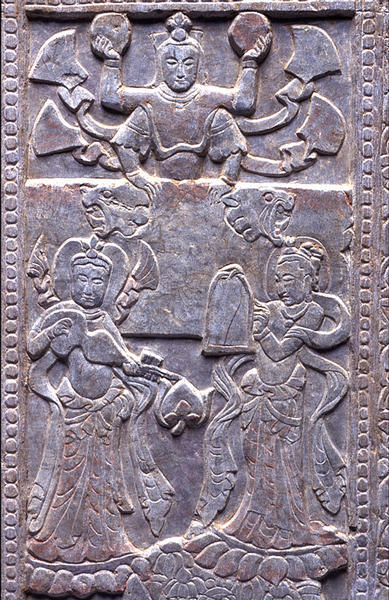
Nanaya (top) on a relief from the Miho funerary couch (Miho Museum; reproduced here for educational purposes only)
For the most part the evidence is limited to theophoric names, though. Due to unfamiliarity with Sogdian religious traditions and phonetic differences between the languages there was no consistent Chinese transcription of Nanaya’s name. I have no clue if Chinese contemporaries of the Sogdians were always aware of these elements in personal names referred to a deity. There is a fringe theory that Nanaya was referred to as Nantaihou (那那女主, “queen Nana”) in Chinese. However, the evidence is apparently not compelling, and as I understand the theory depends in no small part on the assertion that a hitherto unattested alternate reading of one of the signs was in use on the western frontiers of China in the early first millennium CE. The alleged Nantaihou is therefore most likely a misreading of a reference to a deceased unnamed empress dowager venerated through conventional ancestor worship, as opposed to Nanaya.
Among members of the Sogdian diaspora, in terms of popularity Nanaya was going head to head with Jesus and Buddha. The presence of the latter two reflected the adoption of, respectively, Manichaeism and Buddhism. Manicheans seemingly were not fond of Nanaya, though, and fragments of a polemic against her cult have been identified. It seems ceremonies focused on lamentations were the main issue for the Manichaeans. Sadly there doesn’t seem to be any worthwhile study of possible Mesopotamian influence on that - the only one I found is old and confuses Nanaya with Inanna.
We do not have much of an idea how Buddhists viewed Nanaya, though it is worth noting a number of other Sogdian deities were incorporated into the local form of Mahayana (unexpectedly, one of them was Zurvan). It has also been argued that a Buddhist figure, Vreshman (Vaisravana) was incorporated into Nanaya’s entourage.
Nanaya might additionally be depicted in a painting showing Buddha’s triumph over Mara from Dunhuang. Presumably her inclusion would reflect the well attested motif of local deities converting to Buddhism. It was a part of the Buddhist repertoire from the early days of this religion and can be found in virtually every area where this religion ever spread. Nanaya is once again in elevated company here, since other figures near her have been tentatively interpreted as Shiva, Vishnu, Kartikeya and… Zoroaster.
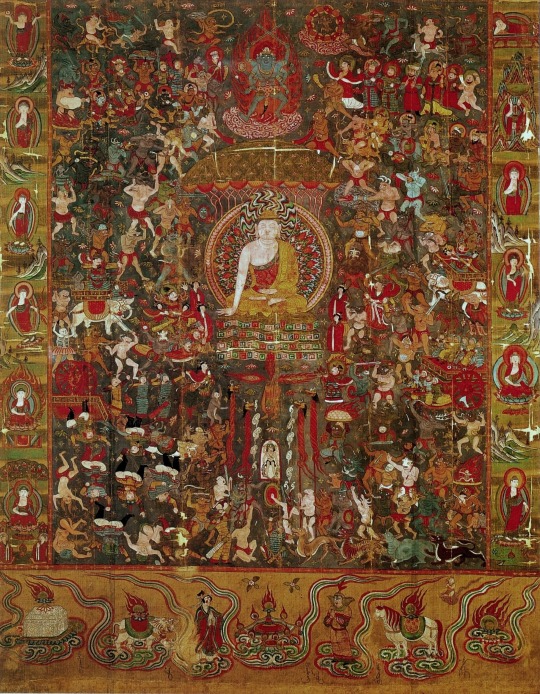
Buddha conquering Mara (maravijaya) on a painting from Dunhuang (wikimedia commons)

zoom in on a possible depiction of Nanaya next to a demon suspiciously similar to Tove Jansson’s Fillyjonk
To my best knowledge, the last absolutely certain attestation of Nanaya as an actively worshiped deity also comes from the western frontier of China. A painting from Dandan Oilik belonging to the artistic tradition of the kingdom of Khotan shows three deities from the Sogdian pantheon: the enigmatic Āδβāγ (“highest god”; interpreted as either Indra, Ahura Mazda or a combination of them both) on the left, Weshparkar (a later version of Kushan Oesho) on the right and Nanaya in the center. It dates to the ninth or tenth century.
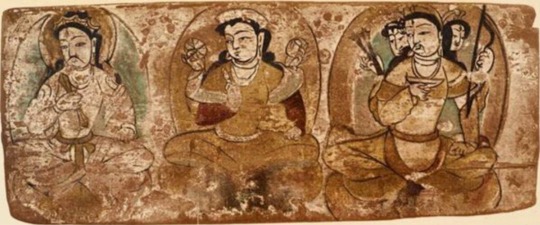
Nanaya (center) on the Dandan Oilik painting (wikimedia commons)
We will probably never know what Nanaya’s last days were like, though it is hard to imagine she retained much relevance with the gradual disappearance of Sogdian culture both in Sogdia and in China in the wake of, respectively, the rise of Islam in Central Asia and the An Lushan rebellion respectively. Her history ultimately most likely ended with a whimper rather than a bang.
Conclusions and reflections
Obviously, not everything about Nanaya could be covered in this article - there is enough material to warrant not one, but two wiki articles (and I don't even think they are extensive enough yet). I hope I did nonetheless manage to convey what matters: she was the single most enduring Mesopotamian deity who continued to be actually worshiped. She somehow outlived Enlil, Marduk, Nergal and even Inanna, and spread further than any of them ever did.
It does not seem like her persistence was caused by some uniquely transcendent quality, and more to a mix of factors we will never really fully understand and pure luck. She is a far cry from the imaginary everlasting universal goddesses such longevity was attributed to by many highly questionable authors in the past, from Frazer to Gimbutas. Quite the opposite, once you look into the texts focused on her she comes across as sort of pathetic. After all, most of them are effectively ancient purple prose.
And yet, this is precisely why I think Nanaya matters. To see how an author approaches her is basically a litmus test of trustworthiness - I wish I was kidding but this “Nanaya method” works every time. To even be able to study her history, let alone understand it properly, one has to cast away most of the dreadful trends which often hindered scholarship of ancient deities, and goddesses in particular, in the past. The interchangeability of goddesses; the Victorian mores and resulting notion that eroticism must be tied to fertility; the weird paradigms about languages neatly corresponding to religions; and many others. And if nothing else, this warrants keeping the memory of her 3000 years long history alive through scholarship (and, perhaps, some media appearances).
Bibliography
Julia M. Asher-Greve & Joan Goodnick Westenholz, Goddesses in Context: On Divine Powers, Roles, Relationships and Gender in Mesopotamian Textual and Visual Sources (2013)
Paul-Alain Beaulieu, The Pantheon of Uruk During the Neo-Babylonian Period (2003)
idem, Nabû and Apollo: The Two Faces of Seleucid Religious Policy in: Orient und Okzident in Hellenistischer Zeit (2014)
Matteo Compareti, Nana and Tish in Sogdiana (2017)
idem, The So-Called "Pelliot Chinois 4518.24". Illustrated Document from Dunhuang and Sino-Sogdian Iconographical Contacts (2021)
Olga Drewnowska-Rymarz, Mesopotamian Goddess Nanāja (2008)
Benjamin R. Foster, Before the Muses: an Anthology of Akkadian Literature (2005)
Andrew R. George & Manfred Krebernik, Two Remarkable Vocabularies: Amorite-Akkadian Bilinguals! (2022)
Valerie Hansen, Kageyama Etsuko & Yutaka Yoshida, The Impact of the Silk Road Trade on a Local Community: The Turfan Oasis, 500-800 in: Les sogdiens en Chine (2005)
Wilfred G. Lambert, Babylonian Creation Myths (2013)
Enrico Marcato, An Aramaic Incantation Bowl and the Fall of Hatra (2020)
Christa Müller-Kessler & Karlheinz Kessler, Spätbabylonische Gottheiten in spätantiken mandäischen Texten (1999)
Lilla Russel-Smith, Uygur Patronage in Dunhuang. Regional Art Centres on the Northern Silk Road in the Tenth and Eleventh Centuries (2005)
idem, The 'Sogdian Deities' Twenty Years on: A Reconsideration of a Small Painting from Dunhuang in: Buddhism in Central Asia II. Practices and Rituals, Visual and Material Transfer (2022)
Tonia M. Sharlach, An Ox of One's Own. Royal Wives and Religion at the Court of the Third Dynasty of Ur (2017)
Michael Shenkar, Intangible Spirits and Graven Images: The Iconography of Deities in the Pre-Islamic Iranian World (2014)
idem, The Religion and the Pantheon of the Sogdians (5th-8th Centuries CE) in Light of their Sociopolitical Structures (2017)
idem, The So-Called "Fravašis" and the "Heaven and Hell" Paintings, and the Cult of Nana in Panjikent (2022)
Marten Stol, Nanaja in: Reallexikon der Assyriologie, vol. 9 (1998)
Michael P. Streck & Nathan Wasserman, More Light on Nanāya (2013)
Aaron Tugendhaft, Gods on Clay: Ancient Near Eastern Scholarly Practices and the History of Religions in: Canonical Texts and Scholarly Practices. A Global Comparative Approach (2016)
Joan Goodnick Westenholz, Nanaya, Lady of Mystery in: Sumerian Gods and Their Representations (1997)
idem, Trading the Symbols of the Goddess Nanaya in: Religions and Trade. Religious Formation, Transformation and Cross-Cultural Exchange between East and West (2014)
Xinjiang Rong, The Colophon of the Manuscript of the Golden Light Sutra Excavated in Turfan and the Transmission of Zoroastrianism to Gaochang in: The Silk Road and Cultural Exchanges between East and West (2022)
Gioele Zisa, The Loss of Male Sexual Desire in Ancient Mesopotamia. ›Nīš Libbi‹ Therapies (2021)
#mesopotamian mythology#sumerian mythology#mythology#bactrian mythology#sogdian mythology#sogdia#nanaya
417 notes
·
View notes
Photo

سعر القطعة 45الف Handmade خدمة التوصيل داخل العراق وكافة دول العالم / كركوك/ شارع المحافظة القديمة / مقابل جامع كركوك الكبير الفرع الثاني/شارع المحافظة القديمة/ قرب فندق الصنوبر ☎️ +9647707552710 . . . . New Collection Luxury #syria🇸🇾 #turkey🇹🇷 #iraq🇮🇶 #kurdistan🇹🇯 #iran🇮🇷 #tunisie🇹🇳 #italiya🇮🇹 #france🇫🇷 #holanda🇳🇱 #kirkuk #libya🇱🇾 #eygept🇪🇬 #dubai🇦🇪 #sudiarabia🇸🇦 #qatar🇶🇦 #sudan🇸🇩#filastin🇵🇸 #austria🇦🇹 #canada🇨🇦 #germany🇩🇪 #sweden🇸🇪 #spania🇪🇸 #lübnan🇱🇧 #maldives🇲🇻 (at كركوك / شارع المحافظة) https://www.instagram.com/p/CppmKSstjHP/?igshid=NGJjMDIxMWI=
#syria🇸🇾#turkey🇹🇷#iraq🇮🇶#kurdistan🇹🇯#iran🇮🇷#tunisie🇹🇳#italiya🇮🇹#france🇫🇷#holanda🇳🇱#kirkuk#libya🇱🇾#eygept🇪🇬#dubai🇦🇪#sudiarabia🇸🇦#qatar🇶🇦#sudan🇸🇩#filastin🇵🇸#austria🇦🇹#canada🇨🇦#germany🇩🇪#sweden🇸🇪#spania🇪🇸#lübnan🇱🇧#maldives🇲🇻
0 notes
Text
AN INTRODUCTION TO "The Loving River", AKA Nazya's story!!
this story takes place in a historic setting in iraq, no specific years (for now) so everything here is subject to some change in the future.

this post is just an introduction to the main stuff and characters in the story! (all under cut, and fair warning, its a lot)
Shanya Al-Malaika:

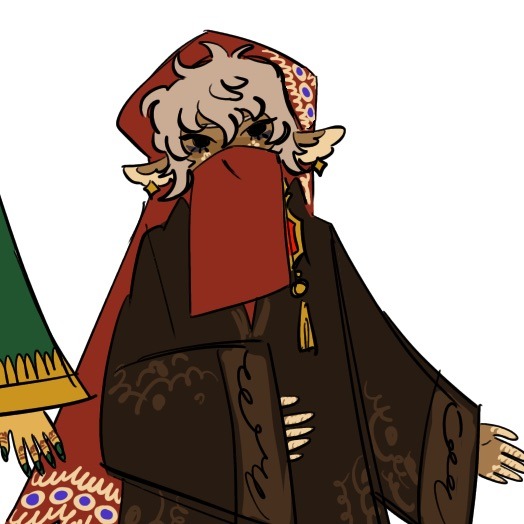
shanya is a 29 year old poet, going by the pen name "Ta'abata Sharan" and taking on the image of a man so she can comfortably write about her love for nazik, and to be taken more seriously in the world of poetry. she is the mortal daughter of the goddess shaahida, also referred to as "The Witness", and ill be explaining more about her and her lore later.
to make a long story short, shaahida never wanted a child, and so shanya's coming into the world was a complete accident, and to shaahida, a shameful mistake. with that, she sends off newborn shanya to live with her aunt, saabira, another goddess, this one referred to as "Patience". saabira had a mortal husband and five mortal children with him, so the choice to send shanya there was easy. shaahida was sure saabira, with all her patience and knowledge of children, would be able to take care of shanya better than shaahida ever could. but of course, if she was going to give away shanya like this, shed have to gain something out of it too. she slashed baby shanya across the mouth with her divine nails, drawing blood, and leaving a scar. a tie between them both, stronger than their familial connection. wherever shanya was, shaahida would be able to keep watch, and when the time comes, shaahida would be able to use shanya as the vessel for her plan (which i'll discuss later,, maybe.)
shanya lives with saabira's family for most of her life in dhi qar, where she meets nazik, a girl around her age, and eventually, falls for her. the two are worlds apart though, for while saabira prefers to live humble and poor despite her divinity, making shanya live as a young sheep herder, nazik came from a wealthy family. middle upper class, to be exact. one day, however, nazik leaves dhi qar suddenly, and without much explanation, leaving shanya all alone. what made it all worse was this coming directly after a major fight/argument between the two. (this is insanely simplified, for a lot of stuff happens between them here.)
shanya continues to live with saabira, until the age of 16. when one day, as she on the carriage of saabira's oldest son, shaheen, she began to tinker with the oud guitar he always had with him. she strummed a few notes and smiled to herself, preparing to play a small tune. the carriage soon hit a bump, and the oud, with all its heaviness, slipped out of shanyas hands and fell off the carriage, tumbling down into the nearby river, and breaking. shaheen went off the rails at this, screaming at shanya about how expensive the oud was, and going as far as slap her and push her out of the carriage, telling her to walk home instead. its then, when shes trying to walk home, in the most vaguest in terms, she ends up dying. very unfortunate, and a horrible look for shaheen.
shaahida oversaw all of this. she was angered, not as a mother would be for a daughter, but a creator to a vessel. she transforms her own body to shanyas likeness, and makes it, in a way, a vessel for shanyas spirit to reside in for the time being. making daughter and mother, one and the same.
after saabira realizes what had happened, shanya's death, shaahida's work, she is frightened, and she does not tell shanya of what had truly happened to her. instead she grabs her and takes her towards kirkuk, where hashim, her uncle, and saabira and shaahidas brother, resides. hashim the god, also referred to as "The Punisher". after learning of what had happened to shanya, hashim takes her in, almost like his own daughter, and he is the one who teaches her of poetry and art and whatnot.
it is also hashim who sends 29 year old shanya out of kirkuk and to baghdad, along with her cousins, the twins jamil and jameela (also saabira's children), to gain more knowledge and more inspiration after she finds herself in a writing block. and that is where shanya meets nazik again after so long, which kickstarts the main story.
Nazik Al-Khafaji:


nazik is the 30 year old eldest daughter to jasim al-khafaji and his university sweetheart, nadeen. young nazik worked in a library with her mother until she was 14, before becoming a 'healer' or a doctor later into her adulthood. she has a younger brother, azra, only 4 years younger. nazik's mother had been a worshipper of saabira, one of the saabiroon, and as such, nazik aligned herself with that sect of worship too. and when push comes to shove, as an adult, nazik realizes she had been blessed by saabira with the power of healing. specifically, healing people with her own blood, something she couldve used much, much earlier.
jasim's family was quite a rich one, and yet, he distanced himself from them and went against his own family's wishes by marrying nadeen, and as such he did not inherit much of their wealth at all, and all the wealth naziks family did have came entirely from his own hard work and businesses in gold selling and jewelry making. nazik's family was originally from baghdad, however after jasim's falling out with his family, they packed their bags and moved to dhi qar when nazik was 6 and azra was 2, which is, of course, where nazik met shanya.
nazik quickly found herself enjoying shanya's company, and even introducing shanya to her brother, for a chance to get the girl to step out of her shell and meet new people, for nazik had noticed how lonely shanya seemed to be, with how all of her cousins were decades upon decades older than her, and having no free time to spend with her at all. nazik found herself skipping many of her classes to be with shanya, almost getting caught by her father many times, but she simply could not get away from her. in her free time she brought shanya books to read with her, though most of the time she sat by and listened to shanya play the oud, yes, the one she often borrowed from shaheen. nazik hadnt realized it, but she had fallen for shanya, hard and deep. one day, after returning home later than she should, after spending a night with shanya, she came back to find her mother dead. nadeen had been sick for years now, but nobody had expected her to die so suddenly. naziks life changed overnight. in the morning, she went to visit shanya one last time, a meeting which resulted in a huge useless argument, before nazik ran off, going home to finish her packing. that night, her, her brother, and her father took a carriage all the way to baghdad. she left shanya with no last goodbye, no last hug, and that is her one regret, though she does not blame herself.
jasim never quite made up with his family, his parents however begrudgingly gave him an estate to own in baghdad, which they settled in. as an adult, nazik was practically the only one working in the house. jasim had given up on life and on fatherhood after nadeen's death, forcing nazik to mother her own brother, and to grow up faster than she shouldve. and while jasim was useless, azra picked up traveling as a hobby, untied and free of all burdens, he was almost never home, and always off doing his own thing outside of iraq, leaving nazik to labor on her own, completely oblivious to the exhaustion she was facing, for she hid it all from him.
nazik, of course, has her own set of people in baghdad, and one of them was a pen pal, jameela, who she did not recognize as shanyas cousin, and whom she had urged to come to baghdad to meet. jameela had of course come to baghdad with her twin brother jamil and her cousin shanya. however, shanya and nazik would not stumble upon eachother until much, much later after shanyas coming to baghdad.
Shaahida (Al-Malaika):
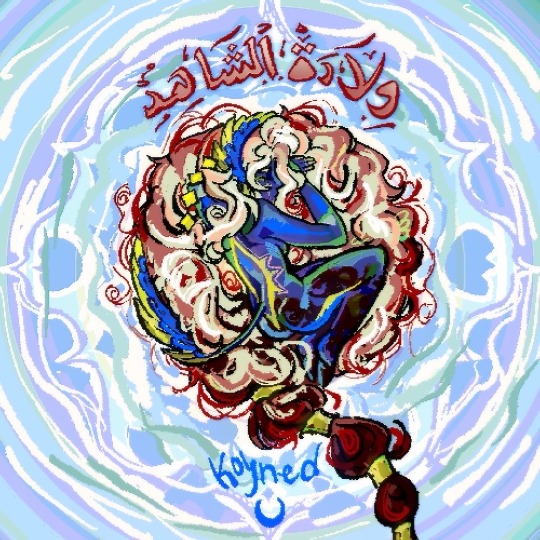

shaahida, the witness, was the second born goddess from "The Creator", coming only after her eldest sister, huda, "The Gift". sources speculate she was born from The Creator's left eye, to bear witness over humanity, and to help her brother, hashim, the punisher, who was born right behind her, in trials, so he may adequately punish both mortals and their divine siblings alike.
of course it must be explained that The Creator is the one true god of the universe, having created it all with humans and all. in their divine eternalness, they split themselves into 99 different pieces, and the one last 100th piece would be created when all 99 pieces set aside their differences and finish their business on earth, and come together to create a new "creator". which is to say, the 99 lesser gods created were much weaker in comparison to The Creator, having a limited set of skills, and being very close to human like with their feuds and problems and personalities. some say there is no way all 99 of them would ever come together to become whole again, for each of them held such wildly different ideologies, and often butted heads with eachother. sometimes mortals wonder if they truly did come from one beings.
each god has their own set of followers that follow certain rules for worship. some gods have easier rules than others, some want all the worship, some want none. while, worshipping one god means you believe in the existence of the 98 remaining, it does not necessarily mean you believe in their coming together again to be one, and it does not mean you believe in them coming from one being. those beliefs depend on the individual and the family they hail from. there is however another religion made from these using all these factors (believing in all gods, their coming from one being and their eventual unity) called "Istiqbal", in the way that its followers await the future for the 'inevitable' unity of these gods.
that being said, shaahida was never one to love her job. as the witness for the punisher, she did not last long. she kept it up merely 3 millennia before giving it up, opting to wander the world meaninglessly for a few couple of centuries, before settling in a temple and watching people worship at her feet all day. along the way, she found herself obsessing with a mortal girl, a girl named batool, and a worshipper of hers. she possessive as much as she was obsessive, and batool did not by any means hate the attention. until one day, when she revealed to shaahida that was to get married to a man soon. of course, that angered shaahida greatly, and with her anger came eyes on them, and the public soon found out about their situation. it was not homosexuality itself that was forbidden, but the act of mingling with mortals at the time was. hashim came, with his divine punishment, and stoned them, though whether he truly wanted to or not was debated. some even said he had someone else come and punish them in his stead. shaahida was hung up and stoned for a whole year, before her mortal lover which of course died before her. after her punishment, shaahidas reputation was tainted forever. humans misunderstood the punishment, thinking it for homosexuality, and quickly forbid it. which, in turn, made shaahida a symbol for homosexuality, and specifically, lesbian love. she would gain a few followers for this, though not many, and all worshipped her in secret. for the next few centuries or millennia, shaahida wandered aimlessly amongst the earth in a disguise, though she did not dare get close to any mortal during that time.
until one day, it suddenly became allowed to get with mortals. a lot of time had passed, and most of her siblings had slowly but surely been becoming more lax on many things. it was frustrating, to think that if her and batool's love was delayed a few mere centuries, it wouldve blossomed to fruition.
shaahida let herself out again, and began to mingle once more with the mortals. she met a writer one day, a man who calls himself abd al sahib. without knowing of her divinity, he spoke to her of his want to write a book about the witness. she smiled, thinking it was flattering. the two got closer, though she did not love him in the way she loved batool, nor in the way lovers loved eachother. he however, was obviously in love and head over heels. and he was not stupid, he soon learned of her divinity and her being the subject of his book, which only made him get closer to her. a series of events unfolds, many that were out of shaahidas control, and she finds herself bearing a child, a mortal child, shanya. for the first few months she had not truly processed it, until one day abd al sahib pointed it out, grinning with pride at the fact that he had impregnated her. her actions next had been a long time coming, she had enough. she killed abd al sahib, which, of course, was a sin. for gods could not murder their subjects and humans in general. it was fine however, for she hid all the clues. and when she brought shanya into the world, she was disgusted. not specifically by shanya, but the events that led up to her birth.
she sends shanya away and goes into hiding, hoping hashim would not find this out.
she loses herself completely in this loneliness and new found hopelessness she has dug herself into, and thinks the only way to get out of it and to be free is to simply become the new creator, to end the world prematurely. and maybe shanya was simply a tool given to her by the world to achieve this.
with that, her loneliness is broken only slightly, and only briefly by her meeting a new woman. nadeen. they got close over a short period of time in baghdad, before shaahida realized nadeen was already married, and already had a few month old daughter. it was shortly after this realization did nadeen leave for dhi qar with her husband and daughter, and shaahida never had much of a chance to see her again. and there she returns to solitude.
.
.
.
and thats all for now! this is barely even half of the story, but again, its just intros, and it's already so long so i dont want to add more. i know not many will read all of this anyway so ive only written this for myself so its easier for me to see the info of my own story here. anyway! heres some art for the characters mentioned!
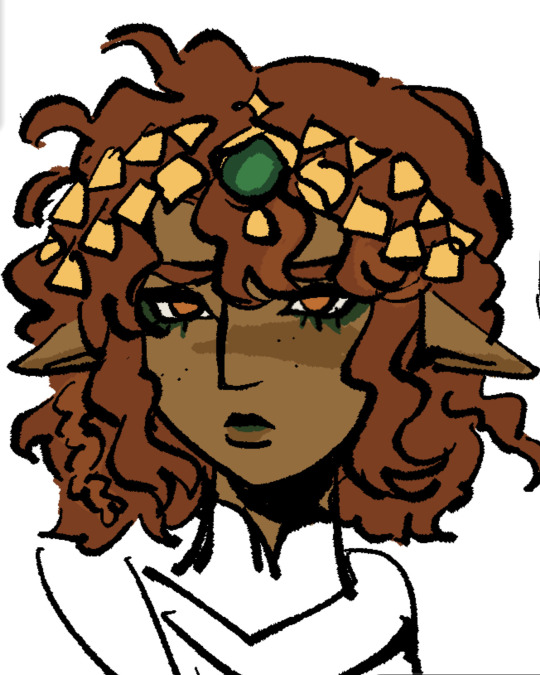
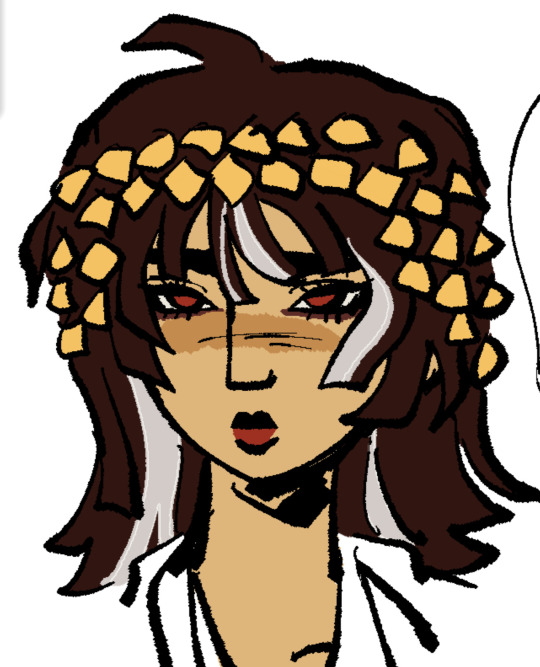
nadeen (left) and batool (right)! this is all i have for now! if youve made it this far, tysm for reading!
#ocs#oc posting#Nazik Al-Khafaji#Shanya Al-Malaika#nazya#yes im giving them their own tags to make stuff easier for me lol#will be adding onto this post whenever i have new stuff or art#insanity#sorry for this being so long i did not mean to write this much ermmmm#if anyone even reads a quarter of this ill be impressed#if some things dont make sense srry i wrote this while sleep deprived#any asks/questions abt the story is very welcome!!!
10 notes
·
View notes
Text


Flag Wars Bonus Round
15 notes
·
View notes
Photo

Ottoman soldiers captured by the British on the Tuzhurmatu Front, Kirkuk. 1918
25 notes
·
View notes